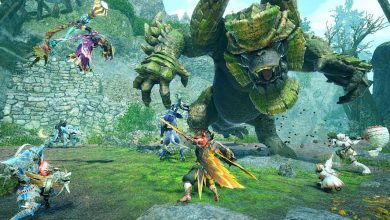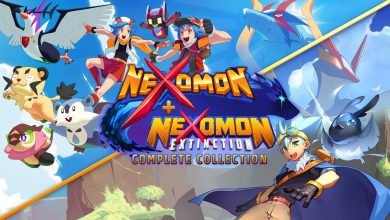“I Wanted The Player To Feel Stunned And Powerless” – Death And Memory In Finji’s Deckbuilding Timeloop RPG
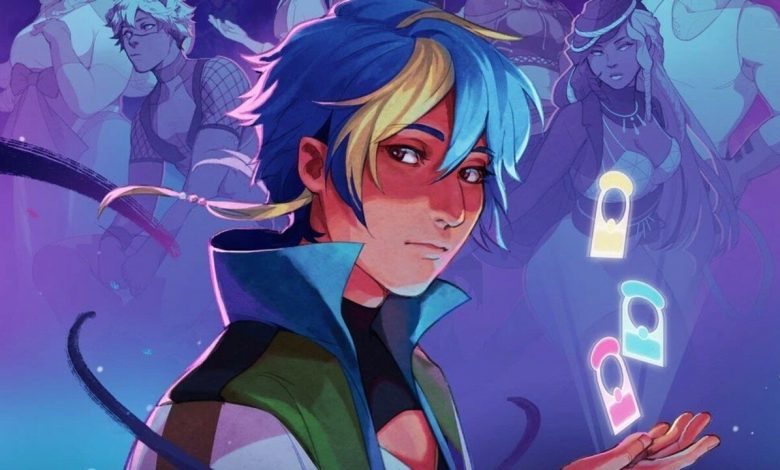
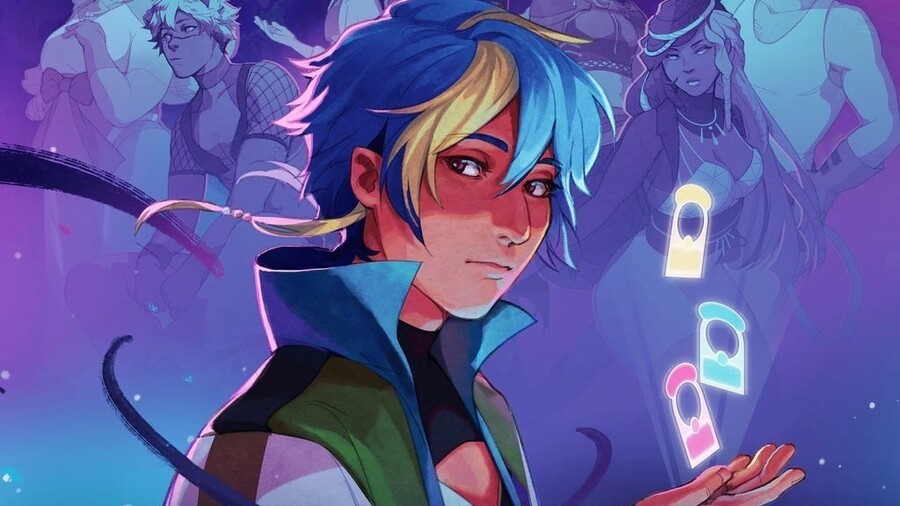
Revealed for Switch back in July, publisher Finji is bringing Northway Games’ I Was a Teenage Exocolonist to Nintendo’s console (and others) on 25th August. A narrative RPG with card-based battles, it sees you growing up in an off-world colony, with all the hardship that brings in addition to the more familiar and typical difficulties associated with navigating your teenage years into adulthood.
It’s a coming-of-age “sci-fi life sim” with card-based bits, then, but one which doesn’t shy away from mature themes and seems to gently reflect some of the existential crises we’re increasingly facing in the real world, albeit in a cosier, less unremittingly bleak manner than the many and various survival game press releases that drop into our inbox on a weekly basis.
After playing a Steam demo of Teenage Exocolonist, we recently caught up with developer Sarah Northway to chat about letting players tell their own stories, the narrative integration of its card-based confrontations and the memories formed from them, and the challenges of avoiding binary design tropes.
Nintendo Life: First off, congratulations on the demo, it does a great job of introducing all the characters and mechanics and offering a rounded experience on its own. Was it relatively simple to slice off that first year of the game as a taster, or is the opening section of the game proper different in any way?
Sarah Northway, Northway Games: Thanks Gavin! The Exocolonist demo is literally just the first year of ten, with a little extra tagged on to the end. I worked to make sure some things were possible in that first year; for instance exploring outside the colony can be done, but it isn’t easy to get your skills high enough.
I also wanted the demo to be replayable, because living many different lives and seeing the story from various points of view is a big part of the full game.
From the off, the nuance of the character writing stands out. As the player is sussing out personalities, there’s a certain unpredictability to responses in the beginning, but careful reading offers hints to traits and suggestions for how people may respond. Can you talk about the process of finding that balance between planting information and not being too obvious with signalling, while avoiding clichés? (Eg. ‘sweet person only likes cute, positive things’, ‘gruff person respects being challenged’, etc)
It was tough finding a balance between making the characters feel natural, and giving you gameplay hooks to hold on to while interacting with them. I’m a game designer with a love of spreadsheets, so I started by giving every character lists of positive and negative personality traits that might conflict in interesting ways.
Then I worked with writer Lindsay Ishihiro to give voice to them all and add much more subtlety to the interactions. Our process was often a push-and-pull between their more mature narrative composition, and my desire for brevity and easily grokable player choices.
The demo year was largely written by me, so it leans more toward simplicity and stereotypes to help ease you in, and to represent how it feels to be ten years old. As the game progresses and the teens grow up, the writing also matures. The characters reveal more complexity and defy many of the expectations we set earlier. Some of them also change dramatically over the ten years in the full game.
[the early-game writing] leans more toward simplicity and stereotypes to help ease you in, and to represent how it feels to be ten years old. As the game progresses and the teens grow up, the writing also matures
Having played the demo through once, despite the relatively small community of characters and activities, we feel like we could have had a very different experience had we focused on other people/areas. How much of that is smoke and mirrors, and how wide do those branching options go in the early stages? I imagine the wider you go at the beginning, the more logistical narrative headaches you create for yourselves in the later-game.
There is so much you won’t see on your first demo playthrough, and some things even change when you play again, including a major event near the start that can play out very differently during your second life.
Events like that do have big cascading effects through the rest of the game, and Lindsay and I mainly dealt with it the hard way, through thousands of conditional statements in our narrative scripts that account for all the possible states of the world and characters.
It also helps that we tell the narrative not just through one linear series of events, but through 800 smaller triggered scenes and storylines that we can turn on or off. You’ll only see a fraction of them during each life depending on how you spend your time, which makes Exocolonist feel more like a living world that doesn’t just revolve around the protagonist.
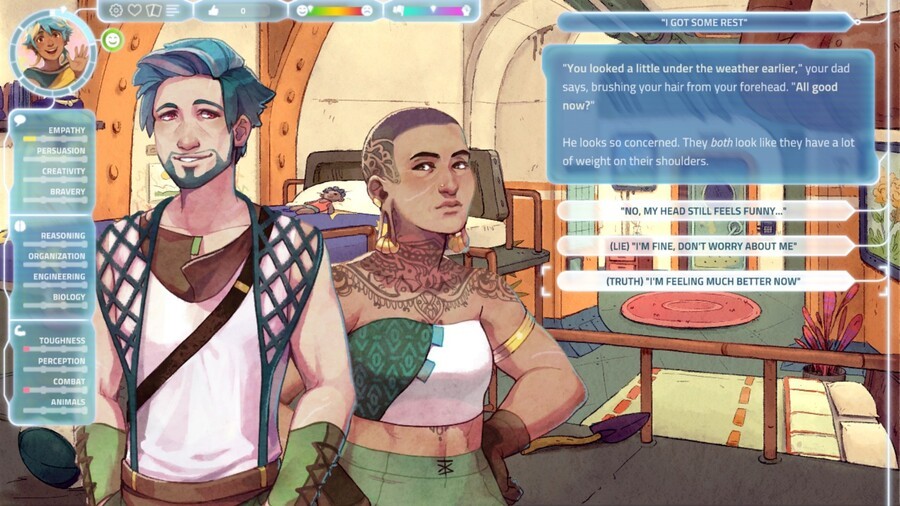
One small moment that jumped out early on had two of three dialogue options that were essentially the same, but one was indicated to be a lie. It was a small moment, but it felt like even that tiny instance of choice early on might set my character down a path and have huge narrative implications. With moments like that, do you lock down narrative branches completely, or is it possible to get back to those particular ‘cells on the spreadsheet’?
We don’t often lock you down based on choices like that, especially so early in the game. Instead, if you choose to lie, your Loyalty-Rebellion bar steps one notch toward Rebellion. It’s a special stat that represents your relationship with the adults and colony government, and has a big effect on late-game options and endings.
Sometimes seemingly minor choices will come up again later, but for the most part they just affect your skills, relationships, cards, and hidden variables that build up over time. Those things all affect what choices you’ll have available in the future.
You mentioned a major event, and without wanting to spoil specifics, a character died in my demo playthrough. It happened suddenly and off-screen, very matter-of-fact and undramatic. Like you say, the world doesn’t simply revolve around the protagonist and there was no foreshadowing or melodrama. They were just suddenly gone. Was it important to you to represent loss in this way, without grand gestures and neat emotional resolutions?
Yes, in this case I wanted the player to feel stunned and powerless. This is how I experienced loss as a child, when I didn’t fully understand what was going on or why, and didn’t know how to react or even feel. As a kid it often seemed like things just happened around me for no reason and there was nothing I could do about it. That’s a vibe I’d like players to pick up on in the early part of the game.
I wanted the player to feel stunned and powerless. This is how I experienced loss as a child
The older you get in Exocolonist, the more emotionally mature options you’ll have for dealing with tragedy and loss (which there will be more of, but also humor and good feels too). We’ve tried to make later events feel less random and disorienting, to reflect the protagonist’s increased maturity.
I admit I wondered if we went too far with that scene though! I always have to look away when streamers play that part of the demo, because I feel guilty about making people cry. Upsetting players is totally something we do on purpose in Exocolonist, but it’s still hard to watch!
The card aspect also feeds into and complements your character’s development. Can you talk a little about the ideas and challenges of integrating character growth and development into the card game?
The cards in Exocolonist are called “memories” and represent events in your life. Often you’ll have a choice between two or three cards with each one tied to a narrative decision. Using your brawn to solve a problem might get you a red “physical” card, whereas choosing to talk it out gets you a yellow “social” card. It’s best to have cards of the same color for the Yahtzee-inspired card game, so this encourages you to stick to your strengths.
Where it gets interesting is with moral choices, where the game might tempt you with a better card when you cheat or steal. Sometimes doing the right thing will even give you a negative card, and the game tells you upfront before you make that choice. I worried this could make players feel forced to break character in order to build a better deck, but I think it’s balanced just right to tempt you without breaking roleplaying.
Exocolonist is about letting players tell their own stories after all, so you can justify your choices however you see fit. And when you look back at your deck at the end of the game you’ll remember all the good times and bad, plus maybe that time you spiked the stew with hot peppers or stole that drone rifle named Kevin.
Having your deck be a ‘record’ reflecting your choices definitely helps explore grey areas and nuances of feeling when it comes to looking back over a life; the journey isn’t just a collection of simplistic, binary choices! Can you talk about your approach to identity and representation in the game, and how you avoided binary design tropes in those areas, too?
So to start with, during character generation we use two sliders to represent the player’s pronouns and gender appearance. Despite the underlying mechanics being discrete (eg. there are only three sets of player art for female/nonbinary/male), it felt right to let players define their character as more feminine or masculine along a gradient.
There is political strife in Exocolonist, but never over gender or race. The Vertumna colony is supposed to be a kind of utopian commune, so our team made it the kind of utopia we’d like to see.
The other characters have personalities loosely defined by their own sliders which change as they age and/or based on your friendship with them. There are some stereotypes (the introverted scientist, the aggressive soldier) but they’re all a collection of many traits and always changing. In terms of representation, we tried to include as many diverse ethnicities and sexualities as we could, including five trans and nonbinary characters. There is political strife in Exocolonist, but never over gender or race.
The Vertumna colony is supposed to be a kind of utopian commune, so our team made it the kind of utopia we’d like to see. It is also largely a reflection of the progressive, multicultural community I’m lucky to live in, being an indie game developer in Vancouver, Canada.
Does an inclusive narrative approach create complications that might not crop up otherwise? I get the impression that a perception exists among some players, and possibly developers, that a broader set of character possibilities are somehow too complex to implement, certainly from a narrative perspective. Typically, games tend to sidestep those challenges with incredibly comprehensive control over your character’s appearance (which usually has no impact on the game whatsoever) and making all NPCs ‘playersexual’ (ie. any NPC is ‘romanceable’ for the player character).
Some things weren’t nearly as hard to implement as I expected, like customizable pronouns for the protagonist, which took less than a day to add to our existing she/they/he slider.
The relationships were another matter, and a labor of love by writer Lindsay Ishihiro, who made even our complex polyamorous relationships with multiple states work. We did decide to go with “playersexual” / “everyone is bi” for inclusivity reasons (everyone wanted to date the straight girl as another girl). But attracting most characters is not as simple as buying gifts to fill a love meter (although that is part of it!). They have complex lives and desires, and might even fall in love with each other instead of the player.
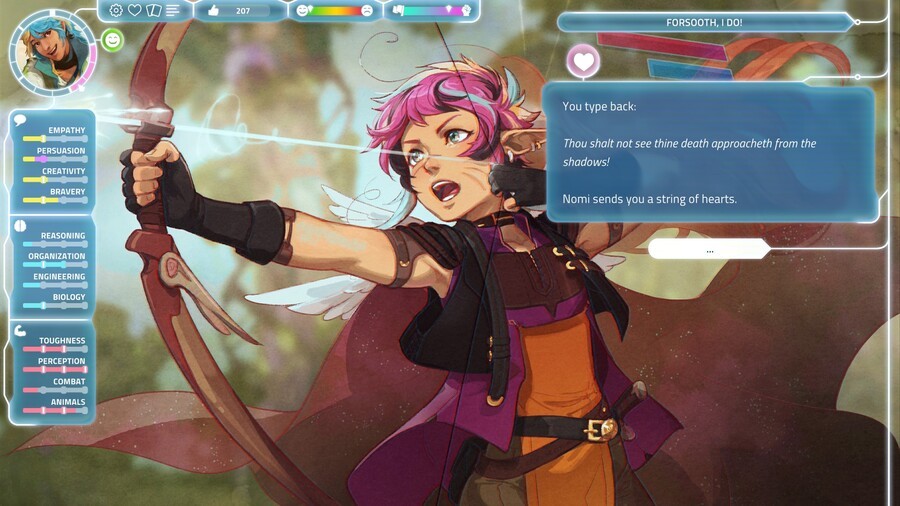
You mentioned that the game is about letting players tell their own stories, and the art style conveys a certain storybook feel. How has that look evolved since you began working on the game and mapping out those narrative spreadsheets?
So initially I was considering doing the art myself, in a much more abstract style without character portraits. When I started working on the dating component, I knew my art wouldn’t cut it. We needed characters you could imagine falling in love with, and suitably beautiful environment backgrounds for them to live in.
attracting most characters is not as simple as buying gifts to fill a love meter. They have complex lives and desires, and might even fall in love with each other instead of the player.
Sarah Webb‘s gorgeous concept art is where the watercolor storybook style came in. We started with the premise that Vertumna would have lush foliage with strongly color-coded seasons, but no native green plants. I’m one of those girls who still refuses to wear pink, so the pastel color scheme was a way to challenge both myself and game industry stereotypes, and to make something that felt unique.
Meilee Chao joined next to design and illustrate our characters and bring Sarah Webb’s concepts to life in the game world. Eduardo Vargas and other artists also continued the style in our backgrounds, 3d models, and other elements. It was a flexible process. If somebody wanted to try something new we’d do it. So I experimented with atmospheric shader effects while Mei and Ed played with animations, and we gradually layered more into the world until it felt right.
Turning to the Switch version specifically, did you make any tweaks to get the game feeling at home on the console? Do you think playing in there will affect the player experience in any way?
Yes! We made some pretty big UI changes for the Switch. Literally! I “embiggened” the interface and increased contrast to make text easier to read and buttons easier to hit with the Switch touchscreen. I also put a ton of work, with the help of Finji QA, into the controller support and the way it interacts with the Switch touchscreen. You can play the entire game with just touch, or just Joy-Cons, or swapping smoothly between the two.
Finally, is there anything we haven’t touched on that you’d like to highlight?
Just that I Was a Teenage Exocolonist will be available on Switch and other platforms on August 25! Thank you!
Thank you, Sarah! As she says, I Was a Teenage Exocolonist is out on Switch, PS4, PS5, Windows, Mac, and Linux on 25th August. Look out for our review nearer the time.
